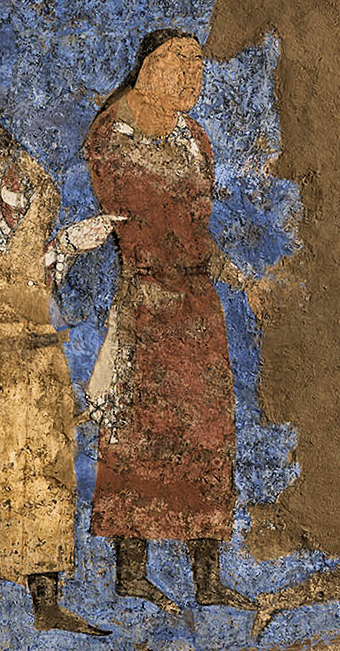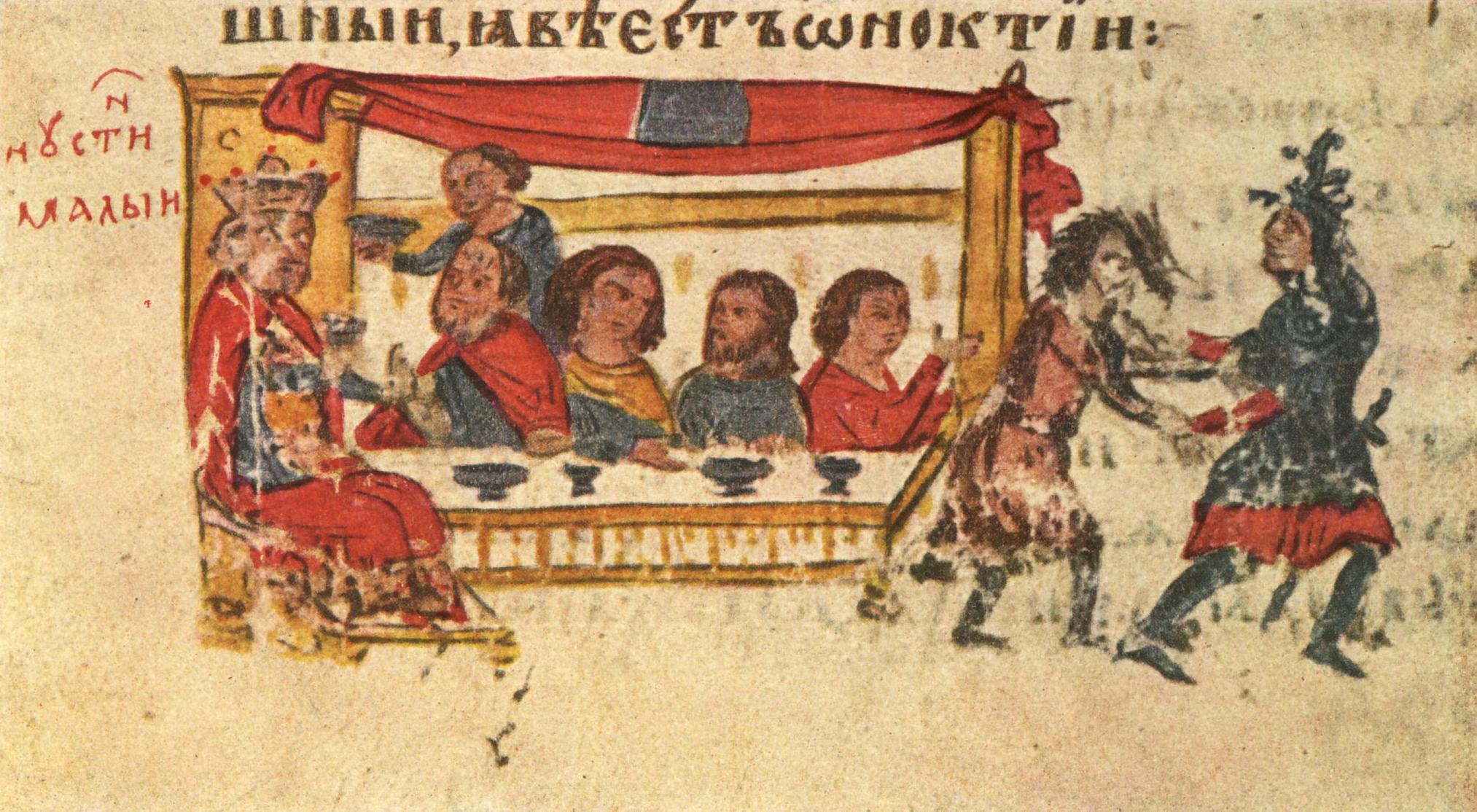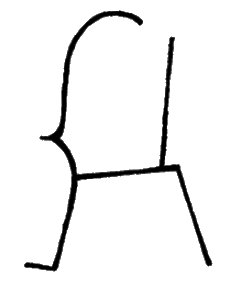|
Istämi
Istämi (or Dizabul or Ishtemi Sir Yabghu Khagan; ) was the ruler of the western part of the Göktürks, which became the Western Turkic Khaganate and dominated the Sogdians. He was the yabgu (vassal) of his brother Bumin Qaghan in 552 AD. He was posthumously referred to as khagan in Turkic sources. His son was Tardu. Activities During his rule Istami established diplomatic relations with the Persian and Byzantine Empires, defeated the Hepthalites, and acted as an elder statesman during the disintegration of the eastern half of the empire. We know a great deal about him from the diplomatic missions of the Byzantine Empire. Shortly after the smuggling of silkworm eggs into the Byzantine Empire from China by Nestorian Christian monks, the 6th-century Byzantine historian Menander Protector writes of how the Sogdians attempted to establish a direct trade of Chinese silk with the Byzantine Empire. After forming an alliance with the Sassanid ruler Khosrow I to defeat the Hephthalite ... [...More Info...] [...Related Items...] OR: [Wikipedia] [Google] [Baidu] |
Western Turkic Khaganate
The Western Turkic Khaganate () or Onoq Khaganate ( otk, 𐰆𐰣:𐰸:𐰉𐰆𐰑𐰣, On oq budun, Ten arrow people) was a Turkic khaganate in Eurasia, formed as a result of the wars in the beginning of the 7th century (593–603 CE) after the split of the Turkic Khaganate (founded in the 6th century on the Mongolian Plateau by the Ashina clan) into a western and an eastern Khaganate. The whole confederation was called ''Onoq'', meaning "ten arrows". According to a Chinese source, the Western Turks were organized into ten divisions. The khaganate's capitals were Navekat (summer capital) and Suyab (principal capital), both situated in the Chui River valley of Kyrgyzstan, to the east of Bishkek. Tong Yabgu's summer capital was near Tashkent and his winter capital Suyab. The Western Turkic Khaganate was subjugated by the Tang dynasty in 657 and continued as its vassal until their collapse. History The first Turkic Khaganate was founded by Bumin in 552 on the Mongolian P ... [...More Info...] [...Related Items...] OR: [Wikipedia] [Google] [Baidu] |
First Turkic Khaganate
The First Turkic Khaganate, also referred to as the First Turkic Empire, the Turkic Khaganate or the Göktürk Khaganate, was a Turkic khaganate established by the Ashina clan of the Göktürks in medieval Inner Asia under the leadership of Bumin Qaghan (d. 552) and his brother Istämi. The First Turkic Khaganate succeeded the Rouran Khaganate as the hegemonic power of the Mongolian Plateau and rapidly expanded their territories in Central Asia, and became the first Central Asian transcontinental empire from Manchuria to the Black Sea. Although the Göktürks spoke Old Turkic, the Khaganate's early official texts and coins were written in Sogdian. It was the first Turkic state to use the name ''Türk'' politically. Old Turkic script was invented at the first half of the 6th century. The Khaganate collapsed in 603, after a series of conflicts and civil wars which separated the polity into the Eastern Turkic Khaganate and Western Turkic Khaganate. The Tang Empire conquered the Ea ... [...More Info...] [...Related Items...] OR: [Wikipedia] [Google] [Baidu] |
Sogdiana
Sogdia ( Sogdian: ) or Sogdiana was an ancient Iranian civilization between the Amu Darya and the Syr Darya, and in present-day Uzbekistan, Turkmenistan, Tajikistan, Kazakhstan, and Kyrgyzstan. Sogdiana was also a province of the Achaemenid Empire, and listed on the Behistun Inscription of Darius the Great. Sogdiana was first conquered by Cyrus the Great, the founder of the Achaemenid Empire, and then was annexed by the Macedonian ruler Alexander the Great in 328 BC. It would continue to change hands under the Seleucid Empire, the Greco-Bactrian Kingdom, the Kushan Empire, the Sasanian Empire, the Hephthalite Empire, the Western Turkic Khaganate and the Muslim conquest of Transoxiana. The Sogdian city-states, although never politically united, were centered on the city of Samarkand. Sogdian, an Eastern Iranian language, is no longer spoken, but a descendant of one of its dialects, Yaghnobi, is still spoken by the Yaghnobis of Tajikistan. It was widely spoken in Central ... [...More Info...] [...Related Items...] OR: [Wikipedia] [Google] [Baidu] |
Justin II
Justin II ( la, Iustinus; grc-gre, Ἰουστῖνος, Ioustînos; died 5 October 578) or Justin the Younger ( la, Iustinus minor) was Eastern Roman Emperor from 565 until 578. He was the nephew of Justinian I and the husband of Sophia, the niece of the Empress Theodora, and was therefore a member of the Justinian dynasty. Justin II inherited a greatly enlarged but overextended empire, with far less resources at his disposal compared to Justinian I. Despite this, he strived to match his formidable uncle's reputation by abandoning the payment of tributes to the Empire's neighbors. This miscalculated move resulted in rekindling of war with the Sassanid Empire, and in a Lombard invasion which cost the Romans much of their territory in Italy. Family He was a son of Vigilantia and Dulcidio (sometimes rendered as Dulcissimus), respectively the sister and brother-in-law of Justinian. His siblings included Marcellus and Praejecta. With Sophia he had a daughter Arabia and possibly ... [...More Info...] [...Related Items...] OR: [Wikipedia] [Google] [Baidu] |
Sogdia
Sogdia (Sogdian language, Sogdian: ) or Sogdiana was an ancient Iranian peoples, Iranian civilization between the Amu Darya and the Syr Darya, and in present-day Uzbekistan, Turkmenistan, Tajikistan, Kazakhstan, and Kyrgyzstan. Sogdiana was also a province of the Achaemenid Empire, and listed on the Behistun Inscription of Darius the Great. Sogdiana was first conquered by Cyrus the Great, the founder of the Achaemenid Empire, and then was annexed by the Macedonian ruler Alexander the Great in 328 BC. It would continue to change hands under the Seleucid Empire, the Greco-Bactrian Kingdom, the Kushan Empire, the Sasanian Empire, the Hephthalite Empire, the Western Turkic Khaganate and the Muslim conquest of Transoxiana. The Sogdian city-states, although never politically united, were centered on the city of Samarkand. Sogdian language, Sogdian, an Eastern Iranian languages, Eastern Iranian language, is no longer spoken, but a descendant of one of its dialects, Yaghnobi language, Ya ... [...More Info...] [...Related Items...] OR: [Wikipedia] [Google] [Baidu] |
Ashina Tuwu
Ashina Tuwu () was an early Tujue chief and ancestor of Göktürk khagans. Besides carrying title of Da Yehu (大葉護 Grand Yabgu) nothing is known about him. Family * Great-Great-Grandfather: Yizhi Nishidu (伊質泥師都) - Mythical ancestor of Turkic peoples, son of a she-wolf * Great-Grandfather: Neduliu shad (訥都六設) - Eldest son of Yizhi Nishidu, legendary ancestor of Turkic clans * Grandfather: Ashina (阿史那) - Youngest child of Neduliu shad, semi-legendary ancestor of Ashina clan * Father: Axian shad (阿賢設) - Submitted to Rouran The Rouran Khaganate, also Juan-Juan Khaganate (), was a tribal confederation and later state founded by a people of Proto-Mongolic Donghu origin.*Pulleyblank, Edwin G. (2000)"Ji 姬 and Jiang 姜: The Role of Exogamic Clans in the Organizati ... * Son: Bumin Qaghan * Son: Istemi Yabgu References {{Göktürks Göktürk rulers 6th-century Turkic people Year of birth unknown Ashina house of the Turkic Empire ... [...More Info...] [...Related Items...] OR: [Wikipedia] [Google] [Baidu] |
Zemarchus
Zemarchus ( el, Ζήμαρχος, fl. c. 569) was a Byzantine official, diplomat and traveller in the reign of Justin II. Biography In the middle of the 6th century, the Göktürks conquered the Sogdiana and thus gained control of the silk trade, which then passed through Central Asia into Sassanid Persia. The Persian king, Chosroes I, dreading the intrusion of Turkic influence, refused to allow the old commerce to continue. The Turks, after many rebuffs, consented to a suggestion made by their mercantile subjects of the Soghd, and in 568 sent an embassy to Constantinople to form an alliance with the Byzantines and commence the silk trade directly with them, bypassing the Persian middlemen. The offer was accepted by Justin II, and in August 569, Zemarchus the Cilician left Byzantium for Sogdiana. This cites: * Menander Protector, ''De Legationibus Romanorum ad Gentes'', pp. 295–302, 380-85, 397–404, Bonn edition (xix.), 1828 (=pp. 806–11, 883–87, 899–907, ... [...More Info...] [...Related Items...] OR: [Wikipedia] [Google] [Baidu] |
Tamgan
Tumgan (also known as Turkshad, Turxanthos or Turksanf) was a shad (governor prince) of the Turkic Empire (also called Göktürk) in the late 6th century. According to Edward Gibbon his name may be a title rather than a proper name. Background In 552 Bumin founded the Gokturk Empire. His younger brother Istämi was viceroy ( Yabghu) in the west. In 575 Istämi was followed by Tardu. By 575/76 Tamgan held some kind of power in the far west around the Volga River. He was probably Tardu's younger brother. Relations with the Byzantine Empire Because of the geographic position of his region, Tamgan was responsible in diplomatic relations with Byzantine Empire. (Hence, the historical sources about Tamgan are mostly the reports of Byzantine envoys). Initially Turkic and Byzantine Empires were allies against Sassanid Iran and Pannonian Avars. However, according to Byzantine historian Menander Protector, a Byzantine envoy named Valentinos visited Tamgan's headquarters where Tamgan ac ... [...More Info...] [...Related Items...] OR: [Wikipedia] [Google] [Baidu] |
Khosrow I
Khosrow I (also spelled Khosrau, Khusro or Chosroes; pal, 𐭧𐭥𐭮𐭫𐭥𐭣𐭩; New Persian: []), traditionally known by his epithet of Anushirvan ( [] "the Immortal Soul"), was the Sasanian Empire, Sasanian King of Kings of Iran from 531 to 579. He was the son and successor of Kavad I (). Inheriting a reinvigorated empire at war with the Byzantines, Khosrow I made a peace treaty with them in 532, known as the Perpetual Peace, in which the Byzantine emperor Justinian I paid 11,000 pounds of gold to the Sasanians. Khosrow then focused on consolidating his power, executing conspirators, including his uncle Bawi. Dissatisfied with the actions of the Byzantine clients and vassals, the Ghassanids, and encouraged by the Ostrogoth envoys from Italy, Khosrow violated the peace treaty and declared war against the Byzantines in 540. He sacked the city of Antioch, bathed in the Mediterranean Sea at Seleucia Pieria, and held chariot races at Apamea where he made the Blue Factio ... [...More Info...] [...Related Items...] OR: [Wikipedia] [Google] [Baidu] |
Ashina Tribe
The Ashina (; Middle Chinese: (Guangyun) ), were a Turkic speaking tribe and the ruling dynasty of the Göktürks. This clan rose to prominence in the mid-6th century when the leader, Bumin Qaghan, revolted against the Rouran Khaganate. The two main branches of the family, one descended from Bumin and the other from his brother Istämi, ruled over the eastern and western parts of the Göktürks, Göktürk confederation, respectively. Origin Primary Chinese sources ascribed different origins to the Ashina tribe. Ashina were first attested to 439, as reported by the ''Book of Sui'': on the 18th day of the 10th month, the Tuoba ruler Emperor Taiwu of Northern Wei overthrew Juqu Mujian of the Northern Liang in eastern Gansu,Wei Zheng et al., ''Book of Sui'', :zh:t:隋書/卷84, Vol. 84. and 500 Ashina families fled northwest to the Rouran Khaganate near Gaochang. According to the ''Book of Zhou'', ''History of the Northern Dynasties'', and New Book of Tang, the Ashina clan was a co ... [...More Info...] [...Related Items...] OR: [Wikipedia] [Google] [Baidu] |
Tardu
Tardu or Tardush Yabghu was the second yabgu of the Western Turkic Khaganate (c. 575–603), and ninth Qaghans of the Turkic khaganates, Khagan of the First Turkic Khaganate (599–603). He was the son of Istämi. Names The regnal name in Turkic was Tarduš ( otk, 𐱃𐰺𐰑𐰆𐱁), Medieval Greek: , , Pinyin: , Wade-Giles: , personal name: , , ). According to Lev Gumilev his personal name was Kara-Churin-Turk (Кара Чурин Тюрк).Lev Nikolayrviç Gumilev: ''Eski Türkler ''(trans. D.Ahsen Batur) Selenge yayınları, İstanbul, 2002 p. 140, 550 However, when he subjugated the eastern half after the death of Tulan Qaghan, he assumed the regnal name Bilge (Wise) Khagan. Background The Turkic Khaganate was a vast khaganate (empire); from Manchuria and the Great Wall of China to the Black sea. It was impossible to govern the whole khaganate from a certain capital. So while the eastern part was directly ruled by the ''khagan'' (emperor), the western part was govern ... [...More Info...] [...Related Items...] OR: [Wikipedia] [Google] [Baidu] |
Constantinople
la, Constantinopolis ota, قسطنطينيه , alternate_name = Byzantion (earlier Greek name), Nova Roma ("New Rome"), Miklagard/Miklagarth (Old Norse), Tsargrad ( Slavic), Qustantiniya (Arabic), Basileuousa ("Queen of Cities"), Megalopolis ("the Great City"), Πόλις ("the City"), Kostantiniyye or Konstantinopolis ( Turkish) , image = Byzantine Constantinople-en.png , alt = , caption = Map of Constantinople in the Byzantine period, corresponding to the modern-day Fatih district of Istanbul , map_type = Istanbul#Turkey Marmara#Turkey , map_alt = A map of Byzantine Istanbul. , map_size = 275 , map_caption = Constantinople was founded on the former site of the Greek colony of Byzantion, which today is known as Istanbul in Turkey. , coordinates = , location = Fatih, İstanbul, Turkey , region = Marmara Region , type = Imperial city , part_of = , length = , width ... [...More Info...] [...Related Items...] OR: [Wikipedia] [Google] [Baidu] |







